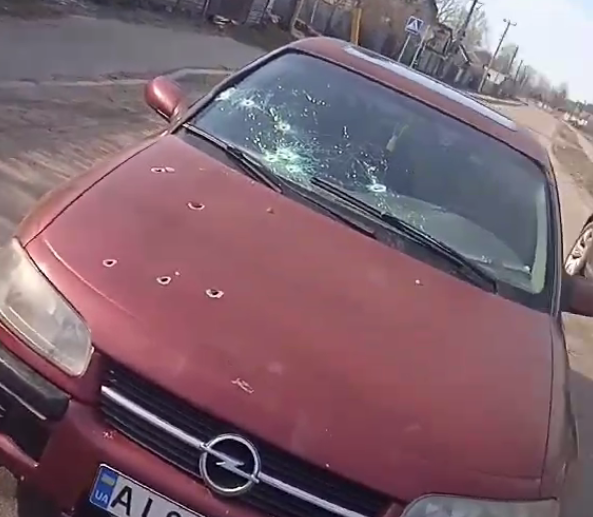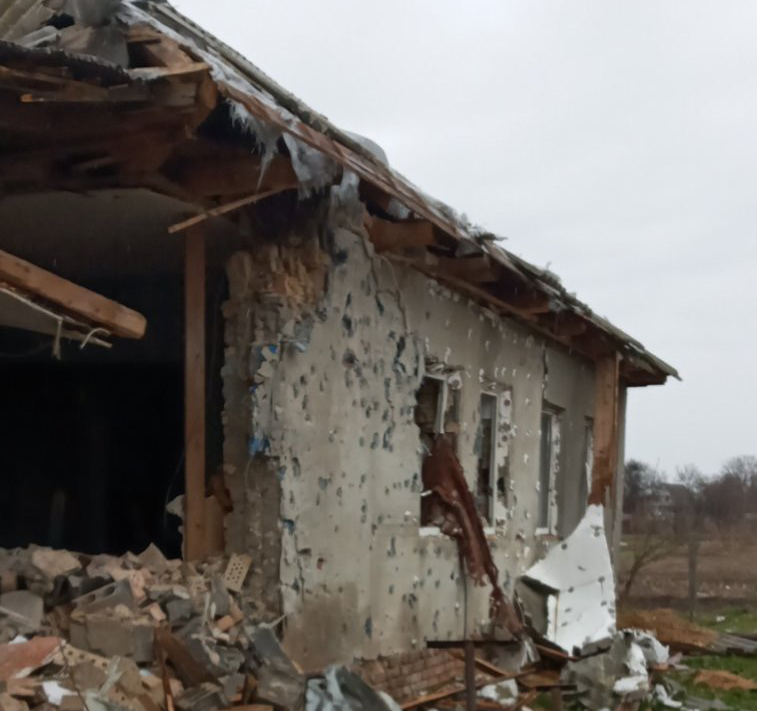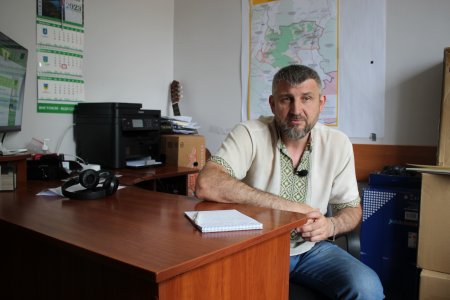I came under fire on the highway. There are twenty-four holes in my car, and it cannot be repaired. [The Russian] drove near in a car, pulled a machine gun, and started shooting at me. I tried to escape and started my car. The engine was damaged; it was running on three cylinders, and he tried to throw me off the road three times. I began to lose consciousness but made it to the territorial defense post. There, they gave me first aid and sent me to the hospital.
Two bullets hit the shoulder, and one ricocheted into the head. He chased me for about 20 minutes, hitting me on the bumper and turning me around, but I continued driving. I was with my wife. Luckily, she wasn’t hurt. On the way to the hospital, they transfused blood twice. We barely made it. I didn’t regain consciousness for a day. Half of my bone is missing, and the muscle is damaged.

Nobody expected this! Shells flew into the fields, and we heard explosions, but we didn’t think it would come to this. When I put out the fire on 14 March (Dymerka was burning), I saw tanks and heard explosions but didn’t evacuate. I didn’t want to leave anything.
There was no electricity, no gas. We cooked over a fire. There was light on some streets, and we charged the phones there. We went to Brovary to buy groceries. It was impossible to pass at the Dymersky turn, so we went there through Hoholiv. It was still possible to break through until the 15th. Then, the fighting started at the crossing. The Russians entered and captured the area. It was already impossible to leave. Constant shellings and debris were falling into the yard. It was restless here.

I wasn’t hiding. My brother has been fighting since 2014, and he said that we could be buried in the cellar during bombardments. And if there is a blast wave, it may throw you out the window. That’s why we didn’t hide anywhere. We were always at home. Wife, child, and me. Three of us. But then we decided to evacuate the child because shells started flying into the garden across the road. We decided to take the child out by car when there was supposed to be a green corridor, but it had never opened. So we decided to go on our own—several people waiting for the green corridor gathered in a group. To avoid too much attention and have fewer cars, we put [the children] in four cars, and they were taken to the station. Everyone who wanted to leave went there.
From the 14th to the 15th, there were explosions almost all night. On the 15th, at about nine, I went to Brovary to buy groceries, but nothing worked there. I went to Brovary but could not return — I came under fire in Hoholiv. Although they say no Russians were there, I came under fire.

About the house
The house is one-story. There were four rooms, a kitchen, and a bathroom; everything was as it should be. The renovation was done, and everything was insulated. There were two hits in the yard, two in the garden, and one behind the house — five altogether. Experts came and said that the house was to be demolished. It shifted from the foundation and cannot be restored. They said that the house was also hit around the 21st. Some [people] were still here. Not everyone left.

There was a Russian tank at the intersection, and where the house is now being rebuilt, there were also two tanks. There were only a few left here: maybe one or two people for five houses. Mostly, everyone left, and the rest sat in the basements until the last minute. It was very troublesome in the village. Just listen to where the Russians lived and how they behaved... They went around and took away everything they could: phones, cigarettes. When one resident got tired of all this and tried to escape, they caught up with him in an armored personnel carrier and shot him.
I returned here when ours cleared everything and started letting people in. It was already possible to return in April. Then, we immediately returned. But without a child. The child was in Lviv all the time. As soon as ours drove them away, we returned.
About Russians
What should I tell them? I want to say a lot of things... I don’t even understand why they came. They have enough land of their own. They have everything. What do they need? Let them follow the Russian ship! [The Russian flagship Moskwa which sank in August 2022]



